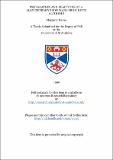Preparation and reactions of 2-alkyltetrahydrofurans from fatty alcohols
Abstract
2-Alkyltetrahydroftirans have been prepared from C₁₀-C₁₈ primary alcohols. Complete characterisation of these compounds by mass spectral and NMR studies has been achieved. Ring-opening reactions of the 2-alkyltetrahydrofurans have been studied and have provided an insight into the chemistry of these compounds, highlighting differences in reactivities and reaction products compared with the parent molecule, tetrahydrofuran. The C₁₀-C₁₈ 2-alkyltetrahydrofurans have been subjected to a variety of ring cleavage reactions involving reaction with Lewis acids and/or acyl halides to produce compounds of the type;
RCH(X)CH₂CH₂CH₂-Y and RCH(Y)CH₂CH₂CH₂-X
R = C₆H₂₉ - C₁₄H₂₉, X = halogen atom, Y = acyl group
This work has demonstrated the ease with which these compounds may be ring opened. In some cases the reaction with the 2-alkyltetrahydrofiirans was observed to be more rapid and vigorous than with tetrahydrofuran itself. This was not always the case: The acid catalysed reaction of tetrahydrofiaran with dodecanol resulted in formation of the diether shown below, and a diester was similarly formed by the acid catalysed reaction of tetrahydrofliran with lauric acid.
R0(CH₂)₄OR diether (R = C12H25) RCOO(CH₂)₄OCOR diester (R= C₁H₂₃)
The analogous reactions with substituted tetrahydrofurans were slow and diether/diester yield was extremely low. Introduction of the alkyl group at position two of the tetrahydrofuran ring severely impeded the reaction. Instead the hydroxy ethers shown below were the major cyclic ether derived products.
C₁₂H₂₅-O-CH(R)(CH₂)₃-OH and C₁₂H₂₅-O-(CH₂)₃CH(R)-0H.
(R = C₆H₁₃)
Oxidation of the 2-alkyltetrahydrofurans was readily achieved by treatment with ruthenium tetroxide and resulted in formation of the corresponding alpha-alkyl-gamma-lactones and gamma-keto acids in almost quantitative yields and
RCO(CH₂)₂COOH
(R=C₆H₁₃-C₁₄H₂₉)
Type
Thesis, PhD Doctor of Philosophy
Collections
Items in the St Andrews Research Repository are protected by copyright, with all rights reserved, unless otherwise indicated.

